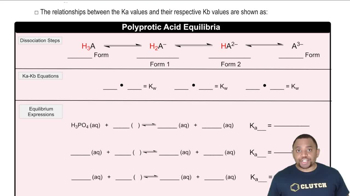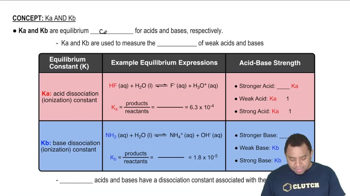Here are the essential concepts you must grasp in order to answer the question correctly.
Acid-Base Equilibrium
Acid-base equilibrium refers to the balance between acids and bases in a solution, which is governed by the dissociation constants (Ka and Kb) of the acids and bases involved. In this case, HF is a weak acid that partially dissociates in water, while HCl is a strong acid that completely dissociates. Understanding how these acids interact in solution is crucial for calculating pH and the concentrations of various species.
Recommended video:
Triprotic Acid Equilibrium
pH Calculation
pH is a measure of the hydrogen ion concentration in a solution, defined as pH = -log[H3O+]. To calculate the pH of a solution containing both a weak acid (HF) and a strong acid (HCl), one must consider the contributions of both acids to the hydronium ion concentration. The strong acid will dominate the pH calculation due to its complete dissociation, but the weak acid's dissociation must also be accounted for.
Recommended video:
Dissociation Constants (Ka)
The dissociation constant (Ka) quantifies the strength of an acid in solution, indicating the extent to which it donates protons (H+) to water. For HF, with a given Ka of 3.5 x 10^-4, this value helps determine the equilibrium concentrations of the species present in the solution. Understanding how to apply the Ka value in conjunction with the concentrations of the acids allows for the calculation of the concentrations of H3O+, F-, and other species in the solution.
Recommended video:
Characteristics of Ka and Kb
 Verified step by step guidance
Verified step by step guidance


